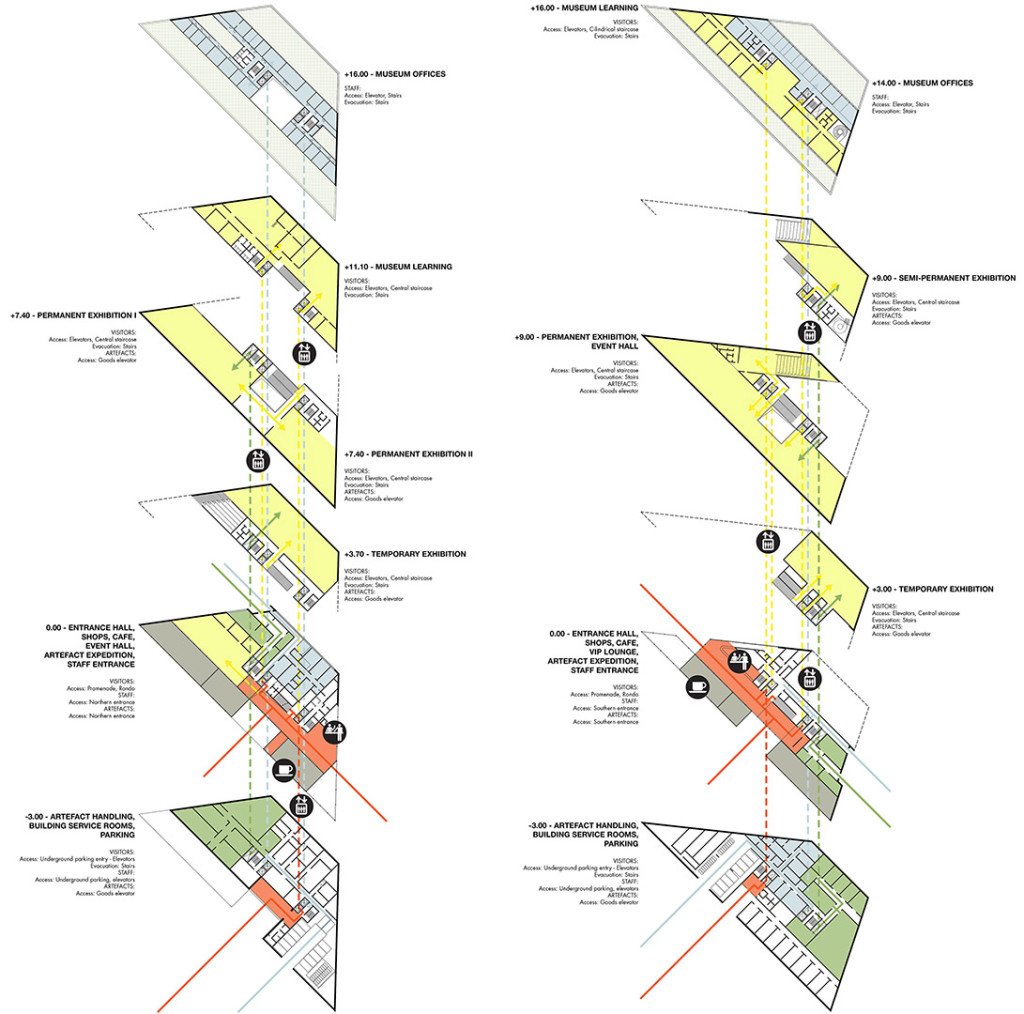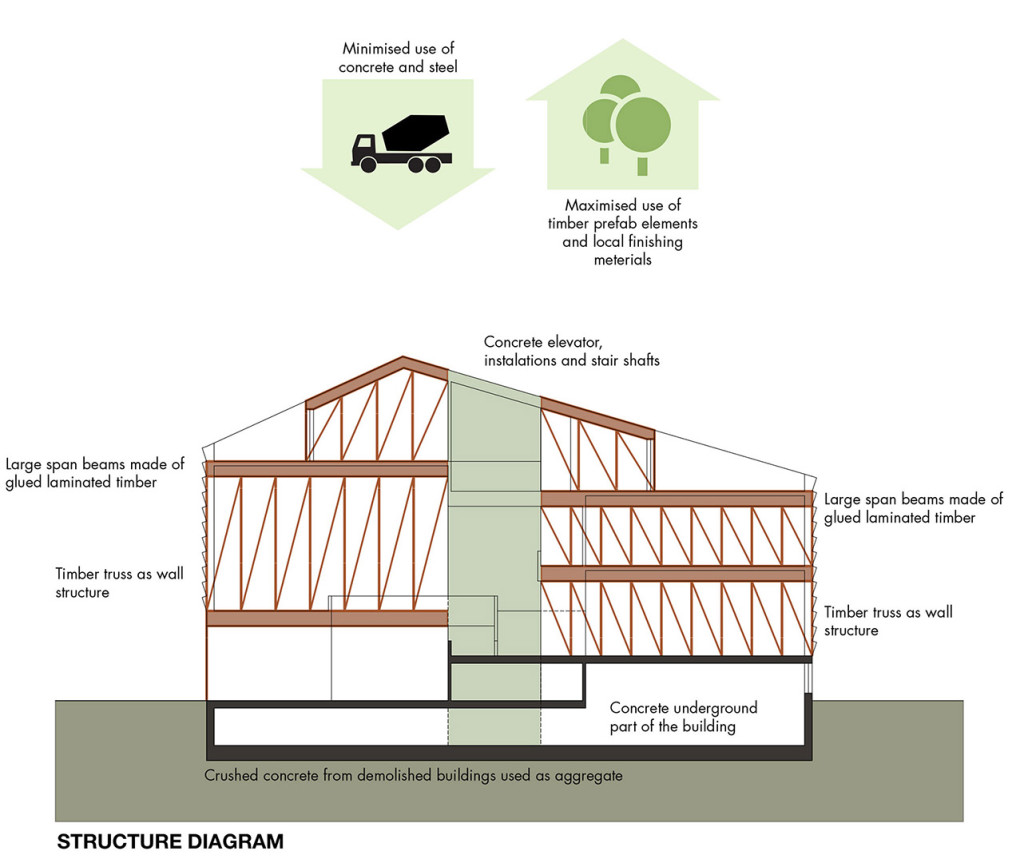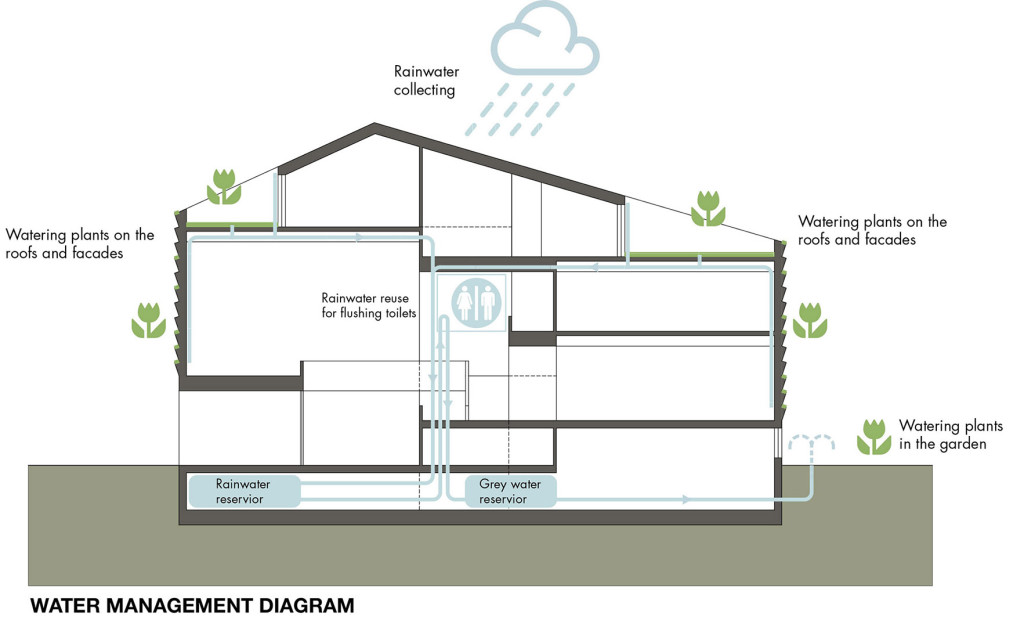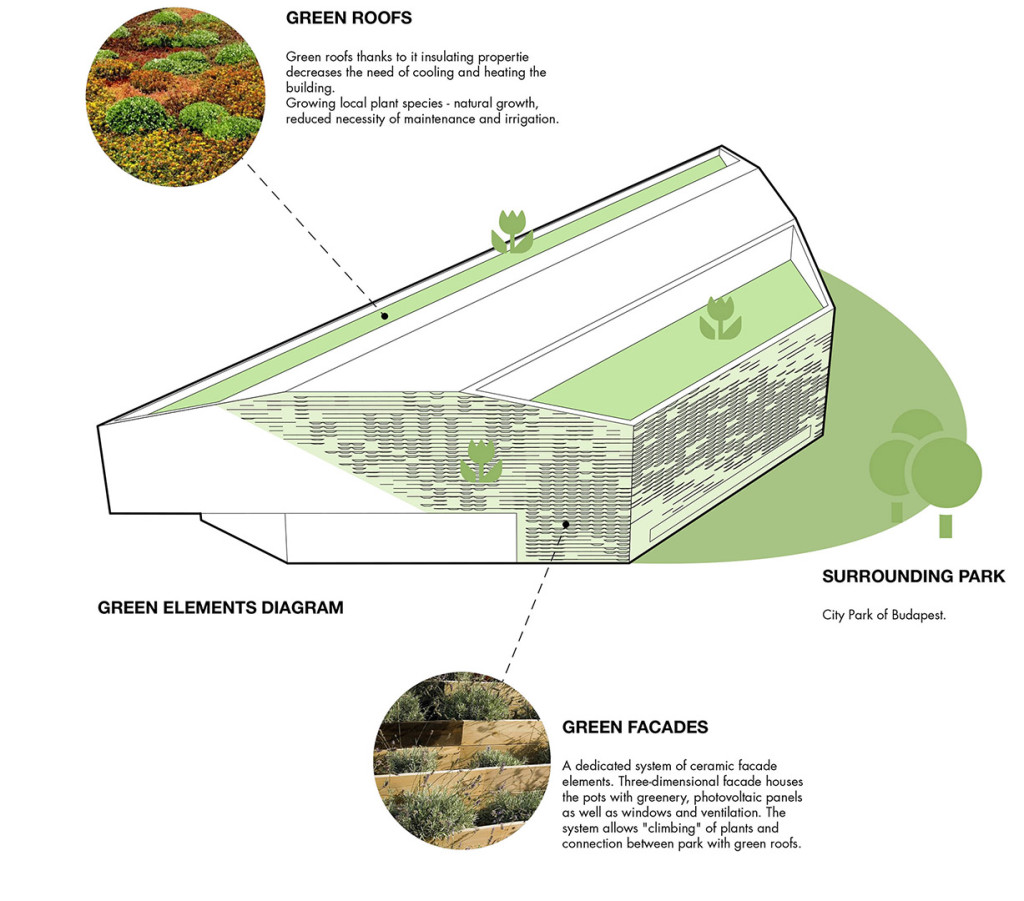1. The authors vision
Fotomuzeum Budapest and the Hungarian Architecture Museum are interesting and dynamically developing cultural institutions, which new headquarters will be located at the edge of the dense urban fabric and the park. They will be built in the immediate vicinity of major urban assumptions: public promenade along Dózsa György Street, Monument of the Revolution of 1956, Városligeti Allée urban axis and reconstructed park with the Rondo. The basic premise of this project is to create modern, open and green buildings representing the spatial and symbolic gateway to the City Park.

2. Architectural concept Both the Fotomuzeum Budapest and the Hungarian Architecture Museum has been designed as
clear, simple solids ordering a complicated context. Positioned on both sides of Monument of the Revolution of 1956 and the surrounding square, form a spatial framework and emphasize very important for the Hungarian society public place.
Buildings with trapezoid floor plans are set along the promenade with the longest sides. They create a slightly asymmetrical arrangement adapted to the course of urban axis. Monolithic solids hiding exhibition spaces have been raised above the ground and opened up at the promenade. Irregular chamfered roof planes allow to obtain two slightly different forms of
dynamically behaving in a different context. Beveled edges refer to the roofs of the historic building as well as creating a central point – the Monument of the Revolution of 1956. Buildings are gaining a unique look on each side, in each view.
Due to the location between the city and the nature, a feature representing the uniqueness of the two proposed buildings is of the dialogue between the simple, clear, smooth forms reminiscent of product technology and porous, filled with vegetation “natural” structure. For this purpose, unique facade elements system was designed for photography and architecture
museum buildings. Inside variable three-dimensional shapes both pots with plants and photovoltaic, windows or ventilation can be placed. Elements form irregular pattern – different in each of the buildings. The presence of different species of plants will ensure a smooth transition of the appearance of proposed architecture – depending on the time of day, the
season or the cardinal directions. With this solution, the external appearance of the two museum buildings is an expression of creative symbiosis between man and nature. Maximum open ground floors of buildings invite people strolling along the promenade, square at the Monument of the Revolution of 1956 and Rondo. The internal spatial arrangement of
buildings is a composition of vertical and horizontal spaces. In both buildings, both entry from the promenade and Rondo lead to long entrance halls. From this place, through the high halls, visitors get to higher floors to visit the exhibitions. Last floors of the buildings, hidden under the sloping undulating roofs are topped with openings allowing distant views of the city skyline
and City Park. Spaces designed inside buildings are simple and clear. Multilevel system of galleries and educational parts allows the creation of intriguing spatial and visual connections. This causes a certain kind of interaction between different parts of the building, encouraging visitors to use all of its resources. At the same time spatial arrangement, by its simplicity and clarity is not trying to divert attention from exposure – is it a neutral background.

3. Site relations
The immediate context of new residences of Fotomuzeum Budapest and Hungarian Architecture Museum is a diverse urban fabric – from urban villas in Városligeti Allée, the tenement houses, the modernist blocks up to the late post-modern office buildings. The location
on the border of the park, puts buildings museums, in a sense, in opposition to the urban fabric. Simple, clear blocks are not trying to make a dialogue with each neighboring building, do not compete with the environment and only organize them, highlighting the main objectives
of urban planning.
From the analysis of the height of adjacent buildings, the average building height ranges from
12-13 meters at Városligeti Allée to 26-28 meters with Dózsa György Street. The height limit
for museums of photography and architecture is 25 meters, but because of the aspect ratio, as
well as the desire to merge into the environment designed Fotomuseum is 21 meters high and
Architecture Museum – 23 meters. With the roof surface slants front facades of both buildings
are 17 meters high.
Buildings designed with the trapezoid plans are much narrower in the park than on the
promenade. Avoiding sharp angles, museums gently slide into the trees. Vegetative pattern on
the facade suppresses clash with the park. Greenery climbs up the facades to green roofs. The
buildings coexist with the natural environment. Thanks to the proximity of greenery they are a
unique place of culture. The park itself, however, by two museums located at the entrance
gains protection from the noise of the city. Last floors of buildings, including office spaces are
open up to the magnificent view of the treetops.
The aim of the project is to revitalize the space, changing its current destination. To build the
urban character of the environment, commercial zone was located along the promenade.
There are museum shops, cafes with shady terraces, commercial premises for rent. Located in
the second row, behind services, entrance hall has a connection to both the promenade and
Rondo. This space, deep and open, invites to interact both in the commercial and cultural
sphere. Staff entrance and the place of delivery of the artifacts are on the side facades – the
Fotomuzeum from the north, and in the Architecture Museum of the south..
The buildings are located in such a way, as to create an architectural framework for both the
public promenade and the reconstructed park Rondo. The main facades are facing southwest.
Opening on the top floors create a long view of the city center and the park.
Access to the building is provided directly from the underground car park located under the
promenade. Visitors through the lobbies and elevators can get straight to the main halls.
Museum staff has internal parking for cars and bicycles located under buildings accessible
from public parking. Bicycle parking for visitors, bays for buses and public transportation stops
are located at the level of the promenade. Outline planning a public promenade provides for
the use of crossing streets for entrances to the parking lot and the coach bays. Between the
bays and buildings of the museums there is a space serving organization groups of visitors.
Further, in front of the entrance to each building there is a fountain designed as landmarks.
Bike path leads along the entire promenade. At every entrance to the underground car park
there are parking spaces for bicycles. The idea for the boardwalk, Rondo and the park should
be the maximum openness to pedestrians and cyclists, while reducing vehicular traffic.

4. Operation and technology
Visitors of the museum move through the sequence of spaces of different character. Horizontal
lobbies lead to vertical space with central staircases. From there, at different levels galleries
start. Museum learning is located above them. Exhibition spaces have different heights and
proportions. It allows exposing a wide range of exhibits.
All exhibition halls, warehouses and workshops are equipped with lighting, humidity and
temperature control systems corresponding to the highest standards. Permanent work rooms –
workshops and warehouses have access to natural light. Exhibition halls have lighting,
temperature and humidity control systems. Part of the exhibition has access to natural light.
Exhibition halls have the opportunity to reorganize the space as needed. There can be made
more partition walls or curtains. There is also the possibility to combine some exhibition halls..
All exhibition areas and museum learning areas are available from the main halls. The basic
communication shall be stairs, but in the immediate vicinity lifts were also designed. In addition
to functional connections, required by the organizer, in museum of architecture and
photography buildings additional spatial connections are designed. In case of necessity,
organized exhibitions linked thematically or supported by projections and lectures in both
buildings an alternative way of sightseeing can be arranged.
Transport systems in the buildings are based mainly on stairwells and elevators. For each zone
there is access for both fully able people and disabled. In each building there are 4 passenger
lifts and one transport of 16 square meters of surface. It connects all of the levels on which
artifacts are transported.

5. Supporting structure
Because of the ecological approach to design and a desire to impact in many areas at the
same time, the project assumes the maximum reduction in the use of concrete and steel. Their
production results in significant emissions of carbon dioxide into the atmosphere. Reinforced
concrete structure is energy intensive in production as well as future demolition. To reduce that
it is decided to use wood in the terrestrial part of the structure. Prefabricated laminated wood
reduce carbon emissions during production, shorten and simplify the assembly process.
Reinforced concrete structure is only part of the underground structure, lifts, stairs and
installation shafts.

6. Sustainability
Energy saving is realized in the project on many levels. According to three simple rules of
“Trias energetica” project provides the maximum energy saving, high efficiency fossil fuels and
moving towards the use of renewable energy sources.
The project involves the use of heat pumps as a source of heating in the building, reducing air
conditioning for natural ventilation, use of photovoltaic cells, energy-efficient sources of indoor
lighting and maximum use of natural light. Simple solid buildings with relatively small surface
of elevation and green roofs contribute to energy savings..
To improve the quality of work in the proposed buildings they have been designed to use
natural ventilation, mechanically assisted only in extremely adverse weather conditions. All
permanent workplaces have access to natural light. All levels of buildings are equipped with
toilets accessible to people with disabilities. The spaces of childcare and first aid room are
designed in the buildings.

Rainwater collection and re-use systems are designed in the buildings. It is used to irrigate
plants on the roof and facades as well as flushing toilets in the building. There is also the
possibility of recovery of gray water and use it for irrigation of green areas around buildings.
Storage reservoirs are located in the garages of both buildings.

All used materials contribute to the reduction of the environmental impact of the building. The
reduced numbers of reinforced concrete and steel causes the carbon emissions reduce. The use
of precast construction and elevation shortens and simplifies the process of construction. The
project involves the use of local materials and finishing products in order to minimize the need
for transportation. For the development of green spaces, facades and roofs local plant species
will be used. This will facilitate care and reduce the need for additional irrigation.